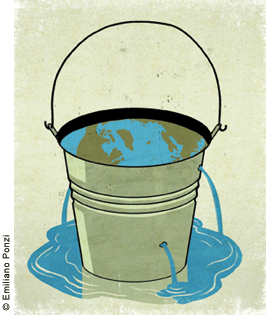
According to Jared Diamond, the multi-millionaires of Los Angeles’s gated communities have more in common with the Mayan kings than they might expect.
In the Mayan Empire, deforestation led to drought and famine, which led in turn to widespread riots and societal collapse. The kings managed to ignore those problems for a while. In their palaces, they basked in luxury while the commoners starved. But eventually, the populace revolted, burning down the royal palaces.
Los Angeles’s modern royalty, Diamond remarked before a large audience in Irvine Auditorium in April, have similarly managed to isolate themselves from their region’s social, economic and environmental problems. While LA is plagued with drought, the rich drink bottled water. While its public school system falters, they send their children to private schools. While the city’s police force struggles to keep crime in check, they employ private watchmen.
But the elite can only insulate themselves for so long, Diamond said. If the polarization of American society continues, he warned, “the gated communities of the United States risk a fate similar to that of the Mayan kings.”
Diamond, a professor of physiology and geography at UCLA and the Pulitzer Prize-winning author of bestsellers Guns, Germs, and Steel and Collapse, was on campus in April to deliver the Philomathean Society Annual Oration, which was also part of a year-long focus on water-related issues sponsored by the Office of the Provost.
His message to Penn students was stark and simple: “We should take environmental problems seriously.”
Successful societies—such as the Netherlands, Iceland, and Japan—did just that, Diamond said. Conversely, some of the most creative and powerful civilizations—such as the Mayan Empire and Easter Island—ended because they ignored their environmental problems until it was far too late.
Diamond talked at length about the Easter Islanders—one of the few groups of Pacific Islanders who possessed writing before European colonization, and the ones who became well known for erecting giant, monolithic statues known as moai. When the first European explorers arrived on Easter Island, it was the one of the most barren, desolate islands they had seen in the Pacific. There were no trees more than eight feet tall. How had the Easter Islanders managed to erect their moai without any access to wood?
“When Easter was first settled by Polynesians,” Diamond explained, “something like a thousand years ago, the island was not the barren wasteland we see today, but was covered by a lush sub-tropical forest.”
But the Easter Islanders began to chop down trees—for firewood, for canoes, for wheels to transport their stone monuments.
“And sometime around the year 1680, the Easter Islanders cut down the last tree on Easter Island,” Diamond said. “And then Easter Island society spiraled down into an epidemic of civil war, during which the 12 or so tribes in Easter Island fought against each other.”
Eventually, Easter Island society collapsed.
“The metaphor is so obvious,” Diamond said. “When the Easter Islanders got into trouble, there were no people that they could summon to come help them. And there was nowhere that they could flee to, now that they no longer had canoes. That’s a metaphor people see for the state of planet Earth.”
But whereas it took the Easter Islanders 700 years to chop down every tree on their 54-square-mile island with stone axes, our planet now holds nearly 7 billion people. And according to Diamond, we have the capability of destroying our habitat at a much faster rate.
We cannot afford, as many would have it, to “balance the environment against the economy,” Diamond stressed. “That reasoning is exactly wrong and exactly upside down.” The environment is not a luxury that a society can put off dealing with until its economy is robust; it is a dire necessity on which every economy depends.
We should take a cue from the Dutch, Diamond suggested. Since the Middle Ages, the Dutch have maintained the world’s most efficient system of dikes. Most of the country consists of drained, reclaimed land called polder. “In the Netherlands, everybody—rich and poor—lives down below in the polder,” Diamond explained. Unlike the Mayan kings, the Dutch elite are not able to insulate themselves from environmental dangers such as flooding.
“If they don’t take good care of the water management system, they’re going to drown along with everybody else,” Diamond said.
—Maanvi Singh C’13




